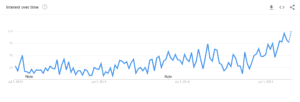
Employer Branding has been an HR buzz phrase over the last few years, as organizations of all sizes across the globe have begun to look at how they’re portraying their company as a place to work.
Before we dive into too much detail and assess where we’re headed, let’s first outline the definition of an Employer Brand.
What is an Employer Brand?
Your Employer Brand is your reputation as a place to work, among both your current and prospective employees.
So, what’s led to this recent interest in Employer Branding? Put simply, the rise of social media.
The rise of social media and publicly available employee accounts on the likes of Glassdoor have led brands to consider what they can be doing to bolster their position as a desirable employer.
Businesses the world over have realized that while an Employer Brand is something they have to own and take responsibility for, it is not something that is totally in their control.
Thanks to research and knowledge around Employer Branding best practices, brands have been able to take steps towards improving this internally, and they’re seeing the benefits.
According to LinkedIn, firms that invest in Employer Branding cut their cost to hire by 50%.
Your Employer Brand simply cannot be ignored and must be continually built on if your goal is to both attract and retain top talent within your organization.

What does the future hold for Employer Branding?
The world is in a strange place, and the working environment has changed significantly for most businesses. The COVID-19 pandemic caused a considerable disruption that saw most companies insisting that their employees work from home, and those that couldn’t had to assess how they could operate as usual without risking the safety of their employees.
These events have led to yet another surge in interest around employer branding. According to Google Trend reports, April this year saw the highest spike in searches around employer branding in over ten years.

Google Trends graph shows interest in Employer Branding at its highest for over 10 years.
Brands are aware of the actions they’re being forced to take, whether it be placing tens, hundreds, or thousands of employees on furlough, or laying-off staff completely.
The repercussions that will come with this, whether it be within their control or not, will significantly affect their reputation as employers.
So, what will be the Employer Branding best practices of the future?

Piyush Sharma (Global CEO Coach and C-Suite & Start-Up Advisor) lends his thoughts on what the future holds for Employer Branding.
Leveraging Employee Communications
“As the world comes to terms with the emerging future of work in a pandemic-struck era, content, technology and employee advocacy will all play a critical role in employer branding that is set to become one of the most critical investments in a company’s arsenal.” – Piyush Sharma (Executive-in-Residence at ISB and at UCLA – is a global CEO coach and a C-Suite & Start-up advisor)
As a business, your employees are the most trusted voices within your organization. People trust people, and 76% of people say they’re more likely to trust content shared by “normal” people over content shared by brands.
The idea of handing the communications reigns to your employees can seem an incredibly daunting and anxiety-inducing practice for many. This is especially true for organizations in sensitive industries like pharmaceuticals and oil & gas.
However, there’s now an array of intelligent employee communications tools that promote Employee Advocacy within a more controlled platform. DSMN8’s Advocacy tool, for example, allows admin users to select, customize, and pre-approve content for sharing. The messaging can be controlled as necessary, right down to the caption copy.
Employee Advocacy can be utilized for far more than just marketing purposes, as an advocacy program should include a content pool that ranges from corporate content to company culture and employee-based content.
If people trust people, then what better way to authentically showcase your working environment than through the people at the heart of your organization?

Utilizing Employee-Generated Content
By now, you’re probably all too familiar with User-Generated Content (UGC). Brands that have implemented UGC campaigns over the years have seen tremendous success, because it utilizes authentic consumer-focused content as a means of promoting their products and services.
Employee-Generated Content (EGC) is the next big step in authentically showcasing not just your products, but in the interest of HR and Employer Branding, your workplace.
It’s no secret that prospective candidates will take to social media to learn more about your company and get a feel of the work environment. Utilizing EGC allows you to not only give them an authentic look of what life at your company is really like, but it also allows them to hear stories first-hand from their future colleagues.

The Changing Role of Social Media
Of course, it’s a no-brainer that a social media presence is an absolute necessity for any brand that’s looking to reach and engage a wider audience.
But how are you using social media? Specifically, how are you using it to showcase your employer brand?
Social media offers platforms for companies to represent their company culture and attract top candidates. Instagram, as an image and video-based platform, is particularly useful for those wanting to offer a behind-the-scenes look at their company.
However, the most effective channel for these efforts is undoubtedly LinkedIn, with its Company Page capabilities, user base, and reputation as a more work-oriented platform.
According to LinkedIn data, over 75% of people who recently changed jobs used LinkedIn to inform their decision. Recruits sourced via LinkedIn were 40% less likely to leave the company within the first six months. This truly emphasizes the platform’s capabilities in not only helping to attract but also retaining top talent.
“LinkedIn takes the cake as the ideal environment to facilitate corporate initiatives thinking ‘community’ in their approach to employer branding. World majors realize it too well and leverage LinkedIn as the preferred one amongst their choice of social media channels” – Piyush Sharma.
Emphasis on Employer Branding might have spiked in the last few years, but the consequences of the pandemic have led businesses to evaluate how they are perceived as an employer in the public eye.
We’re already witnessing brands being held to account in the court of public opinion for the way they’ve handled their staff during this crisis. In such instances, there will inevitably be a rise in distrust among employees towards their employers.
As the world moves towards what will become the new normal for working environments, companies worldwide will have to pay extra close attention to their employer brand if they are to continue to attract and retain quality candidates.
Ready to leverage the power of your employees to solidify your reputation as an employer?
For the comprehensive guide to all things employee influence, download The Ultimate Guide to Employee Influencers.
Lewis Gray
Senior Marketing Manager and Employee Advocacy Program Manager at DSMN8. Lewis specialises in content strategy, growing brand visibility and generating inbound leads. His background in Sales lends itself well to demand generation in the B2B niche.


